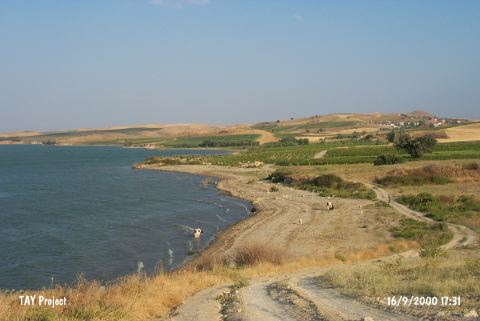|
©The Archaeological Settlements of Turkey - TAY Project
|
|
|
|
|
|
Ahlatli Tepecik |
|
|
For site maps and drawings please click on the picture...  |
For photographs please click on the photo...  |
|
Type:
|
Mound |
|
Altitude:
|
100 m |
|
Region:
|
Aegean |
|
Province:
|
Manisa |
|
District:
|
Salihli |
|
Village:
|
Tekelioglu |
|
Investigation Method:
|
Excavation |
|
Period:
|
EBA I |
|
|
|
 |
|
| Location: It lies 800 m west of the Tekelioglu Village; 25 km south of Akhisar; east of the Manisa Province. The settlement stands on a small hill located on a ridge called Ahlatli Tepecik or locally known as Uzun Tarla/Sigir Tarlasi. |
| Geography and Environment: It stands on an outcrop on the southern bank the Lake Marmara [Mitten-Yügrüm 1969:photo on fig 1]. The mound rises with a soft inclination to the south. The size of the settlement is not reported. Even it is not informed whether it is a mound or not. |
| History: |
| Research and Excavation: It was discovered in 1969; and excavated under the leadership of D.G. Mitten by the collaboration of J. Hendersen and G. Yügrüm in 1967 and 1968. The excavation was not carried out in a wide area but through long and narrow trenches. It was revisited by the excavation team of Sart in 1981; and noticed that the sections closer to the lake have been damaged due to the erosion. Fragments of stone walls and a new cist grave were uncovered during this visit [Greenewalt et al.1983:164]. No information is provided about the possible dating of the stone walls. |
| Stratigraphy: The surface and the excavation finds have laid out that the site had been inhabited from the EBA to the Roman Period. The EBA settlement was uncovered on the southern part of the hill in an area the excavator called the "Southern Cemetery" and in the surrounding territory. The cemetery which also dates to the same period is intense again on the south of the hill. The exposure of a few graves in the trenches near the lake indicates that the cemetery is spread even onto the northeastern parts. It is an extramural cemetery. |
| Small Finds: Architecture: The fragments of walls on the surface which can not be dated indicate the presence of an scanty architecture in the settlement. On the other hand; exposure of some wooden remains demonstrates the presence of hut-like structures. Pottery: Although the deposit of brown soft soil the pits of the pithos graves dug into did not yield any evidence for the presence of any architectural remains; plenty of sherds belonging to the handmade; black washed and burnished ware were recovered. The dominant forms are big bowls. They have horizontal and vertical tub handles. Some bear white painted decorations having lines parallel to each other. Also found are three footed cups. Clay: Spindle whorls of the black and brown ware were recovered. Some were filled in with white paint after decorated with incisions. Chipped stone: Among the tools recovered from the houses are flakes used as scrapers; blades used as sickle-knives and knives; all chipped from flint; quartz; chalcedony and flint. A very limited number of obsidian tools were found. Human remains: Intramural and extramural cemeteries yielded cist and pithos graves. The cist graves were erected by standing stone plates side by side; and then capping it by flat stone plates. They were placed in the cemetery in various directions whereas the pithos graves were generally directed to the east-west. Adults were buried into bigger pithoi while the children into smaller ones with two handles. The 1968 excavation yielded skeletons of elderly women in the pithos graves no. 3 and 6 and a child skeleton in the grave no. 7. This grave with no. 7 is about 45 cm long. The opening; facing the south; was capped by a flat stone. The grave no. 8 was built by placing a pithos and a big jar face to face [Mitten-Yügrüm 1969:pic.6-7]. It has four horizontal horn-like lugs on the neck of the pithos which is 116 cm long and 85 cm wide. A 24-28 years old male was buried into this grave [Mitten-Yügrüm 1969:fig.7]. Grave goods: A vessel with a red surface color; wide opening and handle was left as a grave good inside the grave no. 8. In addition to that; an amulet with a hole made of brown chist and a shroud needle were found next to the skeleton's hipbone. Probably the burials were interred into the graves after being wrapped by shrouds. The grave AT 68-6 yielded a small silver tube with uneven ends. They were produced to be installed on pipes [Mellink 1968:132]. A copper knife and a silver object with a knob-end were found in the same grave. This find exposes that goods were left into graves as gifts. |
| Remains: |
| Interpretation and Dating: Mitten and Yügrüm date the settlement and the cemetery to the first quarter of the third millennium B.C; to the EBA I evaluating them in the culture of Troy. The presence of single handled jugs of red ware is claimed to indicate the possibility of an EBA II settlement [Detweiler et al. 1968:77]. The insufficiency of the excavated area did not yield the relationship between the settlement and the cemetery. Probably the surrounding area of the settlement was employed as a cemetery. |